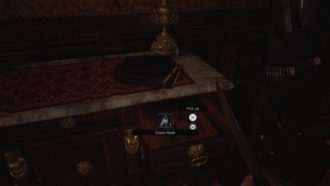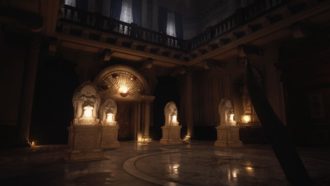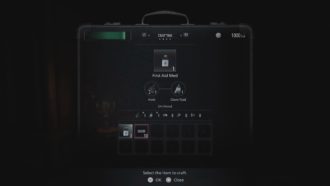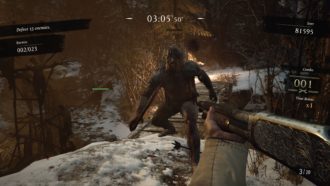Platforms:
Xbox One, PS4, PC, PS5, Xbox Series X|S
Released:
May 7, 2021
Publisher:
Capcom
Developer:
Capcom
Resident Evil Village is the tenth mainline game in the series and the second to use a first-person perspective. The game continues the twisted story of Ethan Winters, following the events of Resident Evil 7: Biohazard. Two demos showcasing the elaborate Castle Dimitrescu and the torn Village area have teased the intense survival horror players will face once again, but what they don’t show is the range of this explosive sequel. A spectacle that not everyone may want.
Set three years after Resident Evil 7: Biohazard, the game begins as Ethan, Mia, and their baby Rose are raided by Chris Redfield and his squad. In the hustle, Mia is shot, Rose is taken, and Ethan is knocked out and ultimately wakes up in a dark and cold place. The Village, as you quickly learn, is abundant with lycan type creatures and other strange monsters. Ethan needs to save his daughter and find out what’s so “messed up” this time.
Tragedy strikes again
Ethan and his family’s story is crushing and gripping. His development from a father with a terrible past into an absolute entity of devotion to finally end it all is compelling. Todd Soley pushes every ounce of rage and passion into his performance of the role, as do actors Katie O’Hagan and Mary Elizabeth McGlynn in their delivery of Mia Winters and Lady Alcina Dimitrescu.
As with any Resident Evil story, the journey goes much deeper than what’s on the surface. Traversing the many zones of this European town, unlocking areas and meeting new characters, the ties between Resident Evil 7: Biohazard and Village slowly reveal themselves. The four houses and Mother Miranda hold deep secrets that really dig their mouldy claws into you until the very end. House Dimitrescu, the first major encounter, is arguably the most engaging with the complex level design and ornate environments of Castle Dimitrescu. The storytelling here is at its strongest, with plenty of diagrams and photographs hidden around to sow the seeds.
“While the escalation does make sense, it feels way too sudden compared to the intimate story of the Bakers in Louisiana.”
Unfortunately, the plot and pacing dip in the middle. House Beneviento is undoubtedly the shortest and least noteworthy part of the tale. There is little character development given to Donna Beneviento and her section easily falls flat against the rest, despite an impressively scary sequence. Salvatore Moreau receives slightly more attention, but players will find the story veer off into a more action-oriented direction. It makes the pacing of the game a rollercoaster and select bosses awkwardly abrupt.
Towards the finale, an unbelievably lazy and massive exposition dump in text documents briefly fills in small gaps in the backstory but still lacks needed detail. The story eventually turns from an eery mystery into a bonkers fireworks fest, and any sense of terror starts to fade. While the escalation does make sense, it feels way too sudden compared to the intimate story of the Bakers in Louisiana. Many plot points may seem familiar or predictable to series veterans, and a few are completely forgotten, with the intense final showdown feeling uninspired.
After seeing the credits, Completion Points are awarded for fulfilling challenges within the main campaign, such as crafting five items or performing hidden tasks. You can exchange the points for extra content like concept art, 3D models, special weapons, infinite ammo, and Mercenaries mode. Mercenaries mode adds more bombastic fun for anyone who enjoyed it in past Resident Evil games or just wants to shoot zombies and get high scores. Combining the end game content with the thrilling journey of the main story, there are plenty of puzzles and action after the initial ten or so hours of the first playthrough.
Galvanising horror action
While the first-person, slow and cautious gameplay returns in Resident Evil Village, it certainly mutates into something else. Ethan begins with nothing but a pistol, shotgun, and knife but will quickly find or buy new weaponry and equipment, like pipe bombs, submachine guns, and a grenade launcher. Improve weapons using accessories like extended clips or by purchasing upgrades from The Duke, this game’s Merchant.
Accelerating combat power reflects the story and keeps gameplay exciting, but it just happens too quickly and easily. Generating money to spend at The Duke’s shop is effortless through killing enemies or finding treasures, selling them for an easy profit and power boost. Note, permanent health upgrades are only awarded by hunting animals for The Duke, which may deter some players. You may want to purposely avoid upgrades or using more powerful weapons until the end of the game to keep as much of the challenge and horror as possible. The game is almost too easy with how strong Ethan can become, and bumping it up to the tougher difficulty might be wise.
“The gunplay is weighty and requires accuracy, every shot packing a serious punch… the DualSense adds to the immersion with fantastic features…”
One of the series’ strongest areas is the gameplay and Village expands and delivers. The gunplay is weighty and requires accuracy, every shot packing a serious punch. With the PlayStation 5 DualSense controller, each weapon has a different response from the adaptive triggers. The sniper is heavy in-game and in your real-life hands, the trigger on the controller mimicking the pressure it takes to fire. Rattling recoil from automatic rifles with the haptic feedback of the DualSense adds to the immersion with fantastic features making the PlayStation 5 version just a little bit better.
On the other side, exploration and puzzles contrast nicely against the action. Resident Evil Village is very much a Metroidvania, working from the central hub and navigating unknown areas that evolve as the game progresses. While backtracking isn’t always necessary, extra puzzles, collectables, and story details are rewarded to those who take the time to explore. Discoverable optional and gruesome bosses with very creative puzzles help break up the major beats of the story. It’s remarkably fun to return to the Village after a milestone in the campaign, only to realise passages have changed ever so slightly and for you to figure out how and why.
The inventory system has changed, as well. Items like keys, treasure, crafting materials, and notes are now separate from the main inventory and don’t add to any space restrictions. Without having a case to store items, this is a sensible design decision to avoid dropping and losing valuable collectables. Unlike the previous game, accessing the inventory now pauses the game. While these alterations improve accessibility and quality of life, it certainly takes away from the threat of being vulnerable.
Up close and personal
Resident Evil Village is an impressive looking game. It fully utilises the PlayStation 5’s new hardware, with incredible lighting and detailed textures that bring together unique environments. Extreme close-ups of disgusting creatures and their sludgy gashes or deep wrinkles show off the expert modelling. The game has a Photo Mode available for the macabre fanatics who want to take gruelling screenshots and change the depth of field, aperture, add filters and more.
“Every tiny sound puts you on your toes. Creeks in floorboards or wooden planks, guttural growls from infected, and the wet crunch when Ethan is pummeled to death…”
House Heisenberg may be one of the most intricately designed and terrifying environments in all of Resident Evil history. Without giving away too much detail, this section is similar to Castle Dimitrescu if it was darker, more violent, and utterly void of any hope. Tomonori Takano’s art design and Kazumasa Koroda’s visual effects flourish throughout the game but truly shine in this spot.
Audio design and sound effects enhance an outstanding visual experience, with impressive sound staging supported by the PlayStation’s virtual 3D audio. Every tiny sound puts you on your toes. Creeks in floorboards or wooden planks, guttural growls from infected, and the wet crunch when Ethan is pummelled to death by an enemy are rich with object-based surround sound. There is no better way to play this game than with a high-quality audio setup.
With all this high-definition sound and graphics, Resident Evil Village still performs exceptionally well. At a steady framerate, the game has only a few hiccups with some lighting and animation oddities. For example, interactable objects in dark areas may be lit awkwardly and when switching weapons quickly it may look like Ethan has a third arm. Minor bugs that surely will be squashed with patches.
8
Great
Positive:
- An action-packed story with plenty of horror
- Combat is thrilling, especially with DualSense adaptive triggers and haptic feedback
- Incredible world design with terrifying environments
- Impressive audio design and mixing
Negative:
- Some character development and plot devices are ignored
- Changes to gameplay and mechanics may disappoint fans of RE7
After the too close for comfort clash with the Baker family in Louisana, Resident Evil Village attempts to match that creepy tone and do more. Much more. As a result, this tale has facets of methodical horror combined with the ridiculous action of Resident Evil 5 or 6. While some players may not enjoy one or the other, undeniably Capcom does both very well. A better mix of the survival horror and extreme action could have made this stronger overall, as the messy pacing, lacking antagonist development, and easing difficulty hurt the overall adventure. The final package is still a wonderful spectacle of a video game. It’s entertaining, it’s engrossing, and it’s Resident Evil in every aspect. With the best visual/audio design in the series’ and a satisfying Metroidvania world design, Resident Evil Village is unmissable.























